STANLEYMUSEUMOFART 23 20



160 W. BURLINGTON STREET
IOWA CITY, IA 52242
319-335-1727
stanley-museum@uiowa.edu
stanleymuseum.uiowa.edu
Follow us @uistanleymuseum
Gallery Hours
Monday: Closed
Tuesday: 10 A.M.–4:30 P.M.
Wednesday: 10 A.M.–4:30 P.M.
Thursday: 10 A.M.–8 P.M.
Friday: 10 A.M.–4:30 P.M.
Saturday: 10 A.M.–4:30 P.M.
Sunday: 1–4:30 P.M.
Admission to the museum building will end 15 minutes before gallery closing.
Office Hours
Monday: 9 A.M.–5 P.M.
Tuesday: 9 A.M.–5 P.M.
Wednesday: 9 A.M.–5 P.M.

Thursday: 9 A.M.–5 P.M.
Friday: 9 A.M.–5 P.M.
Saturday: Closed
Sunday: Closed
Editor: Elizabeth Wallace
Copy Editor: Pat Sims
Contributing Freelance Writers: Andrea Truitt, Cassandra Jensen, and Diana Tuite
Design: Benson & Hepker Design ©2023
21 PUBLIC PROGRAMS
The Alchemy of Making
What Is a Campus Museum and How to Become One Franklin Peters Artist Talk

Hervé Youmbi & Willie Cole: A Conversation
Immersive Opera
Write at the Stanley Grant Wood Fellows
A Conversation with Randall Griffey
Art Conservation: Where Science and Art Meet Drawing Salon
Stanley Reads
29 STAFF SPOTLIGHT
Allie Tokarski
30 A LASTING IMPACT
31 FROM THE UI CENTER FOR ADVANCEMENT
Supporting the Stanley… Today and into the Future
We are off to a great start, and we have so many exciting things to look forward to in 2023! On August 26 of last year, I was incredibly honored to stand with University of Iowa President Barbara Wilson, Regent Sherry Bates, Iowa Center for Advancement Director Lynette Marshall, and three UI students and cut the ribbon in front of the entrance to the new University of Iowa Stanley Museum of Art. The weather was gorgeous and the mood joyous. We welcomed 6,000 eager visitors to see our state-of-the-art building and inaugural exhibition, Homecoming, during this opening weekend, and the crowds have not stopped coming. By the end of 2022, nearly 30,000 people had visited the Stanley to stroll through our galleries, attend a class, listen to music, enjoy a public program, or just relax with friends.
In the Stanley’s galleries and classrooms, our world-class collection serves as a catalyst for conversation, critical thinking, and creativity. Visitors to the museum this spring will be greeted by nearly 100 newly installed artworks. These include paintings by Beauford Delaney, Suzanne Valadon, Emmanuel Okechukwu Odita, and Manijeh Yadegar Hall; porcelain teapots by Roberto Lugo; works on paper by Amy Sherald, Carrie Mae Weems, Jaune Quick-to-See Smith, Yun-Fei Ji, Emilio Sánchez, and Lee Bontecou, among many others; and diverse textile works from Canada, Mali, Nigeria, Ghana, Cameroon, Senegal, and Gee’s Bend, Alabama. Through a collaboration with the Obermann Center for Advanced Studies, the Stanley will present a three-channel video installation by Afro-Brazilian artist Aline Motta, whose gorgeous, lyrical work explores the legacies of colonization in the African diaspora.
This spring, we are also presenting a host of exciting public programs that will engage our audiences while supporting our educational mission. A number of these programs, including Write at the Stanley, Stanley Reads, and Book Matters, focus on the written word, affirming our position as a teaching museum on the campus of the Writing University. Other programs offer visitors opportunities to make art themselves, enjoy music, and learn about new trends in art museums from curators and directors including Pamela Franks, director of the Williams College Museum of Art, and Randall Griffey, head curator at the Smithsonian American Art Museum. Visitors will also be able to interact with leading figures in the contemporary art world such as the painter and Iowa alumnus Oliver Lee Jackson—whose stunning diptych is on view in Homecoming—and Acoma potter Franklin Peters, and learn about the fascinating practice of art conservation from paintings conservator Nina Roth-Wells.

Thanks to all of you for being a crucial part of our inaugural year. We are here because of you and hundreds of other museum supporters around the world who love this museum and this campus and who believe in the power of art to transform lives.
Sincerely, Lauren
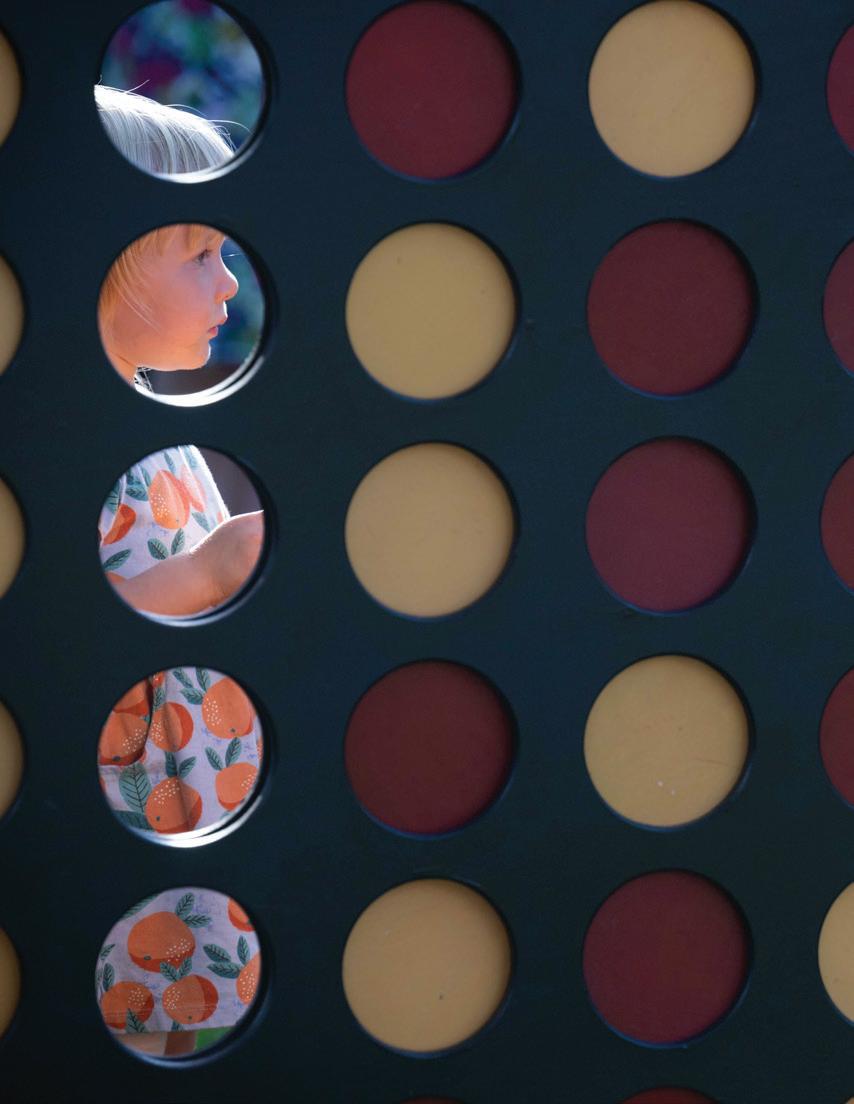 Photo by Tim Schoon
Photo by Tim Schoon
As soon as the applause died down following the August 26 building dedication ceremony, there was a line at the door of the museum. Over the course of the opening weekend an estimated 4,000 visitors viewed the inaugural exhibition and many more enjoyed programming and activities in Gibson Square Park. The broad diversity of visitors seen, and languages heard, in the galleries illustrates that art truly is for everyone. The Stanley is a beacon that will support Iowa as a destination university long into the future.

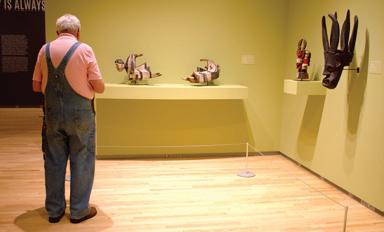
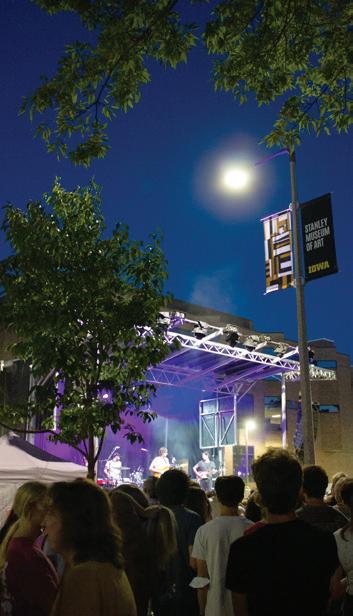
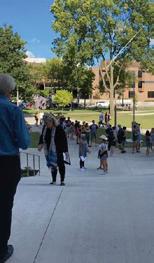
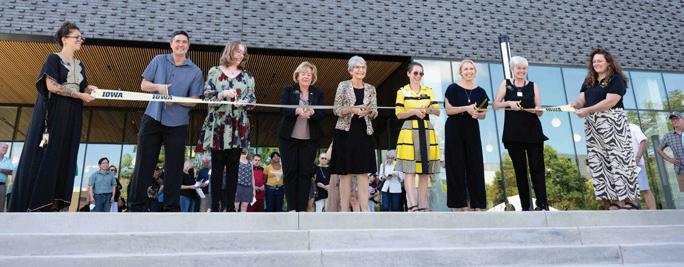




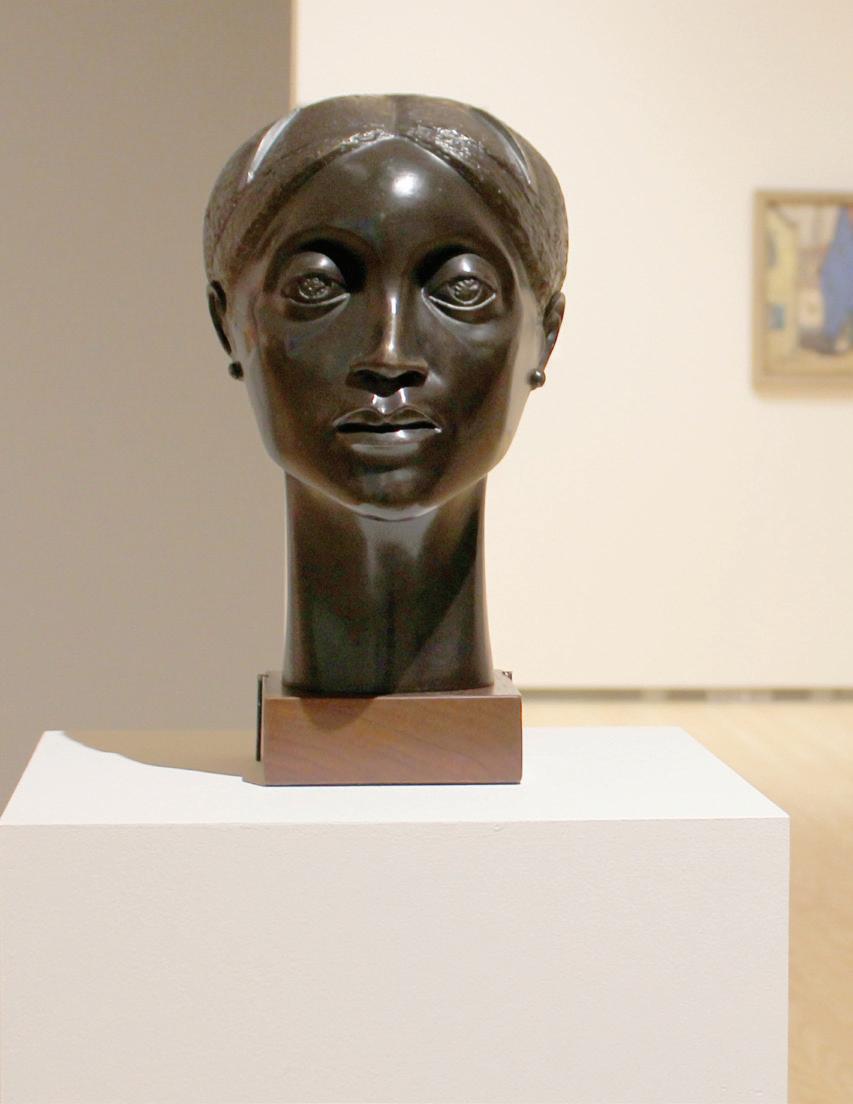 Elizabeth Catlett’s sculpture Glory (1981) seen in Gallery 2 with Blue House, Munich (1928) by Grant Wood and Schnee und Sonne [Snow and Sun] (1911) by Gabriele Münter (rear)
Photo by Elizabeth Wallace
By: Andrea Truitt
Elizabeth Catlett’s sculpture Glory (1981) seen in Gallery 2 with Blue House, Munich (1928) by Grant Wood and Schnee und Sonne [Snow and Sun] (1911) by Gabriele Münter (rear)
Photo by Elizabeth Wallace
By: Andrea Truitt
“HAWKEYE” AND “HOMECOMING” are usually associated with the stadium and arena, not art museums, but here they are. Iowa’s alumni artists are on display in full force across the galleries of the Stanley Museum of Art. You can see work by Elizabeth Catlett, Donté K. Hayes, Oliver Lee Jackson, Ana Mendieta, Okechukwu Emmanuel Odita, Lorraine O’Grady, Charles Ray, and Miriam Schapiro.
“One of the objectives of Homecoming was to reflect upon the university’s history as a progressive, pathbreaking, intellectual community and to position that legacy as a guiding one for the new Stanley Museum of Art,” says Diana Tuite, visiting senior curator of Modern and Contemporary art. For Director Lauren Lessing, “These works demonstrate the strength and pivotal importance of the University of Iowa’s studio art program … It’s not an exaggeration to say that [UI] played a key role in shaping the history of modern art. Video art, Body art, and Intermedia were all developed here.”

Homecoming consists of three main exhibits: Generations (modern and contemporary art), Fragments of the Canon: African Art from the Saunders and Stanley Collections (traditional art forms), and History Is Always Now (contemporary art of Africa, the African diaspora, and Asia). There are also galleries devoted to African masks and textiles and display cases around the light well highlighting ceramics.
Tuite configured Generations to celebrate and reflect more accurately the ways that artists create and contextualize their work: “[The] installation is premised on interconnectivity— the pedagogical, material/formal, and thematic relationships between teachers and students, peers and friends, and family members,” Tuite says. “Ideally, this encourages members of the university and its many communities to take stock of their place within a larger continuum, with all of the awareness and accountability that entails.”
There is no better place to start than Elizabeth Catlett, the university’s first MFA graduate (MFA 1940). Purchased this year, the portrait bust Glory (1981) greets you when you enter the galleries. The subject, dancer and educator Glory Van Scott, looks beyond visitors and time. Her hair, pulled into a bun, and small, round earrings give her, in the artist’s words, an “old-fashioned, modern sophisticated” look, “one kind of beauty in Black women.” The use of a classic sculptural form feels fresh when combined with a modern subject. Van Scott’s two rectangular barrettes, worn above her temples, remind viewers that she is a real person of a specific time, place, and profession. Yet, in casting the bust in bronze, Catlett allows Van Scott to transcend time, creating both a record and a new classical ideal for the late twentieth century.
The acquisition is part of the Stanley’s strategic effort to increase works by UI alumni. Lessing and her team “identified work by important UI faculty and alumni as a collection area that we wanted to grow,” she says, “and we were able to make
some key purchases to support that goal.” The bust complements Catlett’s prints already held in the collection, and show the range of skill and output over a decades-long career. Sharecropper (1968) and Homage to the Panthers (1993) are both on display.
In contrast to a later-career piece, the museum has a student work from sculptor Charles Ray (BFA 1975). Untitled (1973) was created here at Iowa when he was 20. There is, however, a constant in all of his work: the ever-changing spatial relationships created by viewers encountering and interacting with his work. This piece is found in the thematic gallery Human/ Nature. In a recent talk, Tuite described the gallery’s ecological lens (human and material) as art’s role in making community and the cultural ideologies of materials are explored. Ray’s work consists of found wood, brick, and rope, and one may not immediately connect it to the nearby Gee’s Bend quilt Bricklayer (2005) by

Nancy Pettway. Yet both use rectangular shapes, building blocks fundamental to many mediums.

“Charles Ray’s sculpture outwardly challenges many assumptions about sculptural materials, polish, and intention, while preserving the medium’s historical ambitions,” Tuite says. “It is a conceptual piece grounded in his time at the university but it can reveal entirely new dimensionality in proximity to … Nancy Pettway’s Bricklayer quilt.” Still, “[It] raises some eyebrows,” Lessing observes. “But it’s everything you could ever want.” And, she says, “Best of all, it has tension,” noting that the stack of bricks is held in place only by the piece of rope. One push of one brick could destroy the work and all its vibrant tension and precarious balance, a very prescient feeling in a time of climate crisis.
Questions of balance, this time between abstraction and figuration, fuel Oliver Lee Jackson’s work (MFA 1963). Painting (4.78-I) and Painting (4.78-II) (1978) are large canvases that at first appear abstract. Continue looking and under the orange and red circles figures appear, skewed as if on a plane different from ours, encircled and covered by green and blue lines. There is clearly a force at work in them, a simultaneity and layering that we can only observe and reflect upon—we are always outside the worlds Jackson creates in his work. Lessing notes that the space between the paintings, placed on baffle walls, is an “activated, electrified space.” Indeed, stand back and try to comprehend what is happening. Stay awhile and then walk between the paintings, passing into a new world and another gallery.

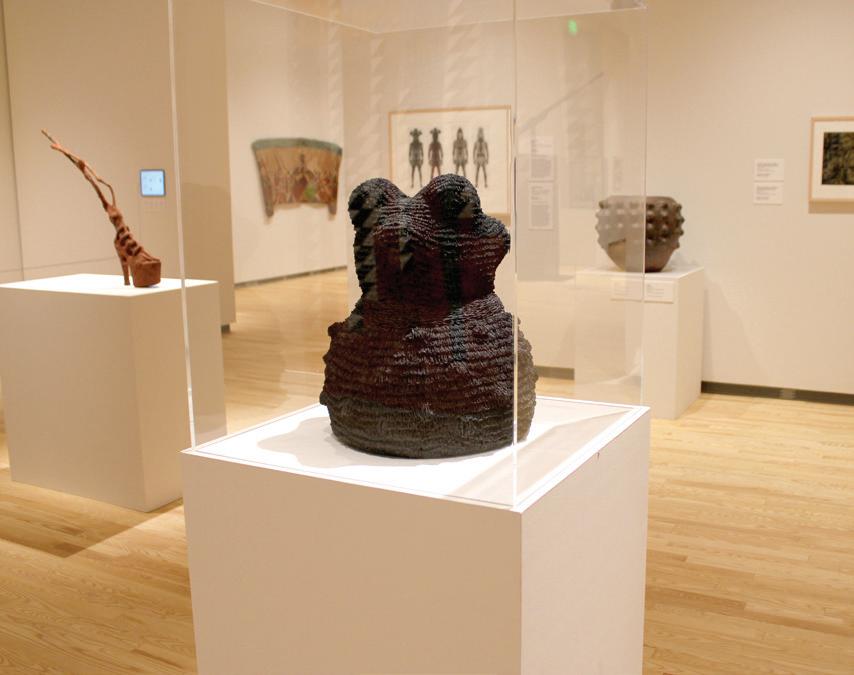
To tell the story of the museum’s African art collection is to acknowledge alumni in different ways. In a personal tour of the galleries, Curator of African Arts Cory Gundlach emphasized the pathbreaking roles that alumni have played in the collection and study of African art as art historians, collectors, and artists. This began in
1957, when Roy Sieber received the nation’s first PhD in African art history at Iowa. Sieber joined the faculty of Indiana University and advised the late Christopher Roy, who spent his career at Iowa. Both guided alumni Max and Betty Stanley as they grew and shaped their collection. This story has been well told, but another alumnus bequest tells a new story. Ophthalmologist Dr. Meredith Saunders represents a crucial
viewpoint: that of a Black collector of African art. Objects from the Stanley and Saunders collections are shown side by side in Fragments of the Canon.

No matter how you experience Homecoming, History Is Always Now will come in the middle of your visit. However, it is one of the most exciting and important spaces to view. “[It] focuses on contemporary artists from Africa, Asia, and America who engage critically with the past and with objects from afar to create meaningful visions about the complexity of contemporary life,” Gundlach notes. “Work by Elizabeth Catlett, Okechukwu Emmanuel Odita, Donté K. Hayes, Eric Adjetey Anang, Willie Cole, and Wangechi Mutu are paired with historic African objects in the collection in ways that highlight Black heritage and support social justice as a central theme throughout the exhibition.”
The object that best represents this is Guardian (2021), a piece commissioned from Donté K. Hayes (MFA 2020). It defies time, or rather it references past, present, and future as Hayes reimagines ritual as a means to reflect on traditional African art forms,
the Middle Passage, the African diaspora, and his lifelong love of science fiction. The bulbous shapes of the work simultaneously reference Frafra-style Ghanaian vessels (on display nearby) and Doctor Who Daleks (not represented, but a nearby print features a robot from Metropolis). The piece seems as if it might ripple and shake at any moment.
“It is powerful to be included in the inaugural exhibition at the Stanley Museum and have work holding space with the art and objects in the exhibition,” says Hayes. “For me it is truly an honor to be in conversation with the artwork of another University of Iowa alum, Elizabeth Catlett. Catlett has inspired me as an artist and person since I was 10 years old. I applied to the University of Iowa because I wanted to be imbued by her presence to continue the legacy of creating art that speaks truth and shows the beauty, intelligence, and humanity of Black people and the African diaspora.”
And we have come full circle: from the original alumna inspiring one of the most recent graduates to acquiring and celebrating alumni artwork, the Stanley presents powerful spaces that challenge assumptions about the relationships between artists, art, and cultures across time, about who and what are included in the art historical canon.
to showcasing the University of Iowa’s Stanley Museum of Art’s extraordinary holdings, Homecoming features a selection of artworks borrowed from collections across the country. One of these, Portrait in Green (1969), is an oil painting by the American artist Lee Krasner on loan from the Pollock-Krasner Foundation, New York. The painting recently appeared in the touring exhibition Lee Krasner: Living Colour organized by the Barbican Centre, London.
On view in the Generations installation, Portrait in Green offers unique insights into a pivotal decade of Krasner’s career. In the 1960s, she abandoned the somber palette she had adopted during a period marked by grief, and reintroduced lush color into her canvases. Krasner enjoyed her first retrospective at London’s Whitechapel Gallery in 1965, and, in the years that followed, undertook subsequent stylistic transitions with enhanced confidence.
By: Diana TuiteUnlike yellow, which Krasner found vexing to work with, green was a color that she perpetually returned to. Portrait in Green heaves with green swells set off by raw canvas and what feel like notational black marks scumbled with white. On assignment to shoot a portrait of Krasner at her home and studio in Springs, New York, the photographer Mark Patiky asked for permission to shoot her while she painted; the artist acquiesced.
Lee Krasner’s pivotal painting will serve as the inspiration for a series of spring events including a Stanley Creates session on February 11. More details will follow in the coming weeks.
Patiky’s 1969 photographs of Krasner at work on Portrait in Green are the first images to capture her intensely physical process. Working without preparatory studies, she preferred for a composition to “happen” on the canvas, and Patiky used a slow shutter speed to reflect this dynamism. Studying the photographs sequentially, it becomes clear that Krasner scaffolded the painting from edge to edge with sweeping green paint before turning to the spaces between these arabesques. The painting’s explosive energy reflects her lifelong interests in the density of Hebrew, Celtic, and Islamic calligraphy and illuminated manuscripts.

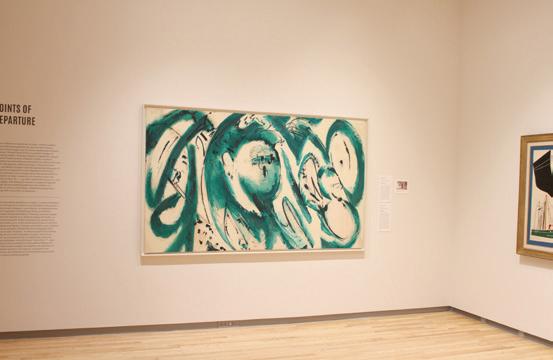
Sharman Hunter, one of the newest appointees to the Stanley’s advisory board, is surrounded by museums. Across from her home in the heart of Charlotte, North Carolina, looms the state’s oldest art collection, the Mint Museum. Around the corner is the Bechtler Museum of Modern Art, a newer building devoted to modern work. Even Hunter’s house could pass for a gallery: she’s a lifelong collector and proud of it, gesturing to a wall or pulling a piece from a shelf whenever referencing an artist she adores. She doesn’t adore works lightly, however. “I don’t collect artists I don’t like, and I try to collect living artists,” she says. “That means something to me.”
Not that she hates the dead, Hunter jokes. She has plenty of pieces from people who’ve died—some inherited from her parents, who also filled their lives with art. Her father was an educator, civil rights advocate, and Peace Corps official; her mother was a seamstress and a nurse. They were part of the Black middle class and started out in the St. Albans neighborhood of Queens, an unusually integrated New York City enclave. Among their neighbors was the well-known sculptor Nina Winkel, the first woman in New York City to earn a welder’s license. As the family relocated to Nigeria, Liberia, and Switzerland, their walls became laden with pieces by their artist friends, mostly representing Black history and culture.
Those early impressions gave Hunter a distinct appreciation for Black artists; current favorites include Derrick Adams and Donté K. Hayes. When she and her husband—Curt Hunter, former dean of the University of Iowa Tippie College of Business— came to Iowa City in 2007, she couldn’t believe its “incredible” collection of African art. After the university’s museum of art flooded in 2008, Sharman Hunter joined a committee to determine where the new museum would be placed—and has continued her involvement ever since.

Her formative years in Africa and Europe, her college days in Maryland, her stint as a preschool teacher, and her career as one of the first Black McDonald’s owner-operators in North Carolina would make for a lively biography—and the next potential chapter would certainly feature the Stanley Museum of Art. During returns to Iowa City, Hunter has admired the new premises: “Even if you don’t walk inside, you’re looking at a building that you have not seen before. The design and where it’s located was so smart.” So, she says, is the arrangement of the interior: in particular, she cites the placement of Sam Gilliam’s powerful painting Red April, inspired by the assassination of the Rev. Dr. Martin Luther King Jr., near Jackson Pollock’s celebrated Mural.
Hunter is also passionate about the Stanley’s innovative programming, including its themed tours for elementary schoolers on field trips. She calls her new board position a thrill and is eager to mingle with fellow members. Most of all, she hopes she can bring a unique perspective to the mix, which, considering her eclectic experiences and the starring role art has played in them, seems positively guaranteed.
Wander into a third-floor corner on the new Stanley building’s east side and you might find Derek Nnuro, curator of special projects, dialing up his office thermostat. Iowa’s autumn weather is temperamental, he explains, doling out sunshine when it’s cheerful and chilliness when it’s stern. “People are always like, ‘This is nothing. You were not here for the polar vortex. You should just enjoy this.’”
To be fair, Nnuro was born in a balmier part of the world: Ghana, where he sets parts of his new novel, What Napoleon Could Not Do. A 2016 alumnus of the Iowa Writers’ Workshop who’s passionate about written and visual expression, he exudes a certain warmth of his own, poking gentle fun at his honest-to-a-fault approach to job interviews and his younger self’s naivete in thinking he could stay on Johns Hopkins’ pre-med track without becoming “distracted” by the arts. “Ironically,” he admits, “my first class at Hopkins was Introduction to Fiction and Poetry.”


Apart from the February 2023 release of his book, which he authored as DK Nnuro, the most exciting event on Nnuro’s horizon is the museum’s forthcoming collection catalog, In a Time of Witness. The catalog features works from the Stanley’s permanent collection accompanied by written responses from University of Iowa alumni: eleven poets, ten fiction writers, and five former residents of the UI’s International Writing Program whose work five literary translators will render in English. Nnuro, who’s been
instrumental in compiling the catalog, looks forward to its 2023 launch event as a literal and figurative homecoming for its contributors.
Nnuro’s role at the museum has never been ordinary. His fascination with ekphrasis, or imaginative commentary on works of art, drew him to the Stanley’s staff, first as associate writer and now as curator of special projects. He’s working with curator of African art Cory Gundlach on an exchange program that will see Black artists connected with the University of Iowa in residence in cities in West Africa. Nnuro is also overseeing two Terra Foundation–funded exhibitions by guest curators: Stanley advisory board member and former UI history professor Jacki Rand, who is currently the University of Illinois UrbanaChampaign’s associate vice chancellor for Native affairs, and Katherine Simóne Reynolds, a young independent curator he calls “brilliant.”
Nnuro will also visit Ghana this winter—just in time to escape more Iowa cold—to continue conversations with his novel’s cover artist, Ghanaian painter Amoako Boafo, about possibly collaborating with the Stanley. Boafo is launching a residency program in Accra, and Nnuro will attend its grand opening with artists from all over the world. It’s a far cry from where he could’ve ended up had he specialized in medicine or even just the written word—but Nnuro doesn’t seem surprised in retrospect. When asked what made him choose curating full time, he just smiles and replies, “I think I’ve always had a visual arts itch to scratch.”
ONGOING Homecoming
Registration and full event information
JANUARY 22, 3 P.M. Visual Classroom Write at the Stanley with David Duer, presented in partnership with Iowa City Poetry. Generate new creative writing inspired by works in the Stanley collection. Adult and teen writers in all genres are welcome.
JANUARY 26, 7 P.M. Lobby
JANUARY 29, 2 P.M. Lobby
Grant Wood Fellow Talk. Johanna Winters will discuss her work and research in performance, video, printmaking, and puppetry.
Alex Kelsh Trio, UI School of Music. Featuring Alexander Kelsh–saxophone, Askar Khaetov–bass, and James Dreier–drums.
FEBRUARY 2, 5 P.M. Lobby
WorldCanvass Reception & Program—“UI Stanley Museum of Art: New Home, New Vision.” In a new partnership with the UI’s Office of International Programs, host Joan Kjaer will lead a cross-disciplinary conversation with Stanley curators and educators.
FEBRUARY 8, 7 P.M. Prairie Lights DK Nnuro Book Talk, a reading of Stanley curator Nnuro’s debut novel, What Napoleon Could Not Do, and a conversation with acclaimed poet and educator Tameka Cage Conley.
FEBRUARY 11, 2 P.M. Lobby
Stanley Creates: Portraits in Green Inspired by Lee Krasner, with Megan Dehner. Kids, teens, and their families will learn about the painting Portrait in Green by Lee Krasner, then create their own abstract artwork using just one color—green. Space is limited. Reserve your spot on our website.
FEBRUARY 12, 2 P.M. Lobby
FEBRUARY 16, 5 P.M. Lobby
Art Conservation: Where Science and Art Meet, presented by paintings conservator Nina Roth-Wells.
Book Matters: Scholars in Conversation at the Stanley. Featuring Mary Cohen, Samantha Zuhlke, and Stephen Warren, all UI community–engaged scholars who have recently published co-authored, collaborative works.
FEBRUARY 17, 1 P.M. Lobby School’s Out at the Stanley. On your day off from school, stop by the Stanley for kid-centered activities and snacks.
FEBRUARY 18, 2 P.M. Lobby Grant Wood Fellow Talk. Michael Dixon will share an overview of his art career, research, and personal narrative, including past projects, current work, influences, research topics, and a discussion of his biracial identity formation.
FEBRUARY 19, 2 P.M. Galleries Drawing Salon, with artist Robert Caputo. Adult and teen participants will draw from artworks in the museum’s collection. Limited to 15 participants. Reserve your spot on our website.
FEBRUARY 23, 7 P.M. Lobby Spriestersbach Lecture, “The Alchemy of Making” by American artist and UI alumnus Oliver Lee Jackson.
FEBRUARY 25, 2 P.M. Galleries Stanley Reads Book Club, What Napoleon Could Not Do by DK Nnuro, presented in partnership with Prairie Lights. What Napoleon Could Not Do is a gripping novel in which America is seen through the eyes and ambitions of three characters with ties to Africa.
FEBRUARY 26, 3 P.M. Visual Classroom Write at the Stanley with DK Nnuro, presented in partnership with Iowa City Poetry. Generate new creative writing inspired by works in the Stanley collection. Adult and teen writers in all genres are welcome.
MARCH 2, 7 P.M. Lobby Pamela Franks Talk—“What Is a Campus Museum and How to Become One.” Franks, director of the Williams College Museum of Art, explores how academic art museums offer rich possibilities for a collaborative and responsive approach to museum practice and museum architecture.
MARCH 3, 1 P.M. Lobby School’s Out at the Stanley. On your day off from school, stop by the Stanley for kid-centered activities and snacks.
MARCH 11, 2 P.M. Lobby Stanley Creates: Collaborative Paper Quilt, with Angie Barr. Kids, teens, and their families will make unique paper quilt squares using collage and paper-cutting techniques. Individual squares will be combined to make a communal artwork inspired by quilts in the Stanley’s collection. Space is limited. Reserve your spot on our website.
MARCH 14–17, 1 P.M. Lobby School’s Out at the Stanley: Spring Break. On your day off from school, stop by the Stanley for kid-centered activities and snacks.
MARCH 25, 2 P.M. Galleries Stanley Reads Book Club, What Napoleon Could Not Do by DK Nnuro, presented in partnership with Prairie Lights. What Napoleon Could Not Do is a gripping novel in which America is seen through the eyes and ambitions of three characters with ties to Africa.
MARCH 26, 3 P.M. Visual Classroom Write at the Stanley with Jennifer Colville, presented in partnership with Iowa City Poetry. Generate new creative writing inspired by works in the Stanley collection. Adult and teen writers in all genres are welcome.
MARCH 31, 10:30 A.M. Lobby Frequências: Contemporary Afro-Brazilian Cinema & the Black Diaspora Panel discussions and keynotes for the 2022–23 Obermann Humanities Symposium featuring filmmakers, translators, and film scholars from the Afro-Brazilian diaspora.
APRIL 6, 7 P.M. Lobby Grant Wood Fellow Talk. Kieron Dwayne Sargeant will focus on his work deconstructing and fusing African-Trinbagonian dances to create movement vocabulary, creative processes, and aesthetics.
APRIL 16, 2 P.M. Galleries Drawing Salon, with artist Robert Caputo. Adult and teen participants will draw from artworks in the museum’s collection. Limited to 15 participants. Reserve your spot on our website.
APRIL 20, 6:30 P.M. Lobby
Hervé Youmbi & Willie Cole: A Conversation. The first in a series of roundtable discussions between contemporary artists working in Africa and the United States funded by the Henry Luce Foundation.
APRIL 21, 1 P.M. Lobby
School’s Out at the Stanley. On your day off from school, stop by the Stanley for kid-centered activities and snacks.
APRIL 22, 10 A.M. Lobby Art Education Community and Family Day. Interactive public programs inspired by objects in the collection. UI graduate students lead art-making workshops, tours, and more. Programs are geared toward young children and their families, K–12 students, and adults.
APRIL 22, 2 P.M. Galleries A Conversation with Randall Griffey. Griffey, head curator of the Smithsonian American Art Museum, speaks with Director Lauren Lessing about Alice Neel’s 1967 painting The Black Boys.
APRIL 23, 3 P.M. Visual Classroom Write at the Stanley with Lenore Maybaum, presented in partnership with Iowa City Poetry. Generate new creative writing inspired by works in the Stanley collection. Adult and teen writers in all genres are welcome.
APRIL 27, 6:30 P.M.
Galleries Immersive Opera by Nathan Felix. Be a part of the premiere of a new one-act, immersive opera by composer Nathan Felix. Performers will move throughout the galleries with different movements or pieces set around the audience.
APRIL 29, 2 P.M.
Galleries Stanley Reads Book Club, What Napoleon Could Not Do by DK Nnuro, presented in partnership with Prairie Lights. What Napoleon Could Not Do is a gripping novel in which America is seen through the eyes and ambitions of three characters with ties to Africa.
MAY 21, 2 P.M. Galleries Drawing Salon, with artist Robert Caputo. Adult and teen participants will draw from artworks in the museum’s collection. Limited to 15 participants. Reserve your spot on our website.
MAY 28, 3 P.M. Visual Classroom Write at the Stanley with Lisa Roberts, presented in partnership with Iowa City Poetry. Generate new creative writing inspired by works in the Stanley collection. Adult and teen writers in all genres are welcome.
On select Sundays this spring, Stanley docents will be leading self-created tours based on their personal experiences, backgrounds, and interests. Sundays with the Docents will give visitors a chance to join a casual tour without the need to register. Keep an eye on the museum website and social media channels for dates, participating docents, tour themes, and other details.
While tightly composed, Jackson’s paintings feel improvisational in approach, as gestural marks become intertwined with vivid swaths of paint and color.
Spriestersbach Lecture: Oliver Lee Jackson
Over the span of five decades, University of Iowa alumnus Oliver Lee Jackson has developed a singular body of work, creating complex and layered paintings in which figural forms meld with abstract fields of vivid color. While tightly composed, Jackson’s paintings feel improvisational in approach, as gestural marks become intertwined with vivid swaths of paint and color. Building over time, each work becomes a synthesis of references that may span from the Renaissance to Modernism, filtered through what Jackson terms his “African sensibility.” The resulting works eschew a single narrative or reading and instead seek to encourage the viewer to form their own emotional response. Creating multiple points of entry within each painting, Jackson states that his work is “for anybody’s eyes; any eyes will do.”
Jackson lives and works in Oakland, California. Originally from St. Louis, he was affiliated with the Black Artists Group, which was founded there in 1968 as an interdisciplinary collective of musicians, actors, and visual artists. Earlier this year, Jackson’s work was the subject of solo exhibitions at the Saint Louis Art Museum, St. Louis, Missouri, and the di Rosa Center for Contemporary Art, Napa, California. Other past institutional exhibitions of Jackson’s work include the National Gallery of Art, Washington, DC, 2019; the Contemporary Art Museum St. Louis, Missouri, 2012; Harvard University, Cambridge, Massachusetts, 2002; the Art, Design & Architecture Museum at the University of California, Santa Barbara, 1985; the University of California Berkeley Art Museum and Pacific Film Archive, 1983; the Seattle Art Museum, Washington, 1982; and the Saint Louis Art Museum, 1980, among others. His works are held in the public collections of The Metropolitan Museum, New York; the Museum of Contemporary Art, Chicago, Illinois; the Museum of Contemporary Art San Diego, California; the Museum of Fine Arts, Boston, Massachusetts; The Museum of Modern Art, New York; the National Gallery of Art, Washington, DC; the Portland Art Museum, Oregon; San Francisco Museum of Modern Art, California; the San José Museum of Art, California; the Seattle Art Museum; Saint Louis Art Museum; the Detroit Institute of Arts, Michigan; and the Fine Arts Museums of San Francisco, among others.
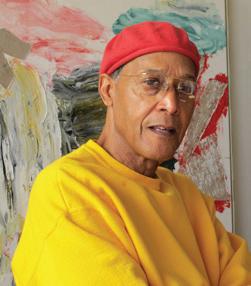
Academic museums are uniquely positioned to act as catalysts in higher education, to serve as bridges between campuses and communities, and to enhance the future of museums. How can we unlock the particular potential of campus museums in our evolving world? Focusing on the early planning of a new building for the Williams College Museum of Art (WCMA) as a case study, this talk explores how academic art museums offer rich possibilities for collaborative and responsive approaches to museum practice and museum architecture.
Pamela Franks is the Class of 1956 director of the Williams College Museum of Art (WCMA). She is inspired by a lifelong belief in the transformative power of art museums for individuals, institutions, and society. Franks has devoted her career to unlocking the potential of college and university art museums—working with students, collaborating with artists, fostering inclusive public and academic engagement, and imagining the future of museum experiences.
Prior to her appointment in 2018, Franks served as senior deputy director and curator of modern and contemporary art at the Yale University Art Gallery (YUAG), where she worked for fourteen years. She previously worked at the Nasher Sculpture Center in Dallas during the period of its construction and opening. A highlight of Franks’s time at Yale was her leadership role in the gallery’s renovation and expansion project. Now she is envisioning the future of WCMA as the museum’s centennial year approaches, in concert with making strategic plans for integrating the arts across the Williams College campus. She holds a PhD in art history from the University of Texas at Austin and is a graduate of the Getty Leadership Institute and the National Arts Strategies Chief Executive Program.
Focusing on the early planning of a new building for the Williams College Museum of Art (WCMA) as a case study, this talk explores how academic art museums offer rich possibilities for collaborative and responsive approaches to museum practice and museum architecture.


This is the first in a series of roundtable discussions between contemporary artists working in Africa and the United States funded by the Henry Luce Foundation. Work by both Cole and Youmbi is featured prominently in Homecoming, the Stanley’s inaugural exhibition. Both Youmbi (a Cameroonian artist who lives and works in Douala) and Cole (an American sculptor, printer, and perceptual engineer) make works that respond to and build upon African art-making traditions while interrogating the colonial practices of art museums in the Western world.
Hervé Youmbi was born in the Central African Republic in 1973 and lives and works in Douala. A passion for drawing and painting led him to attend the Institut de Formation Artistique of Mbalmayo, Cameroon, from 1993 to 1996. There he discovered his affinity for installation art. It was during a brief time at the École supérieure des arts décoratifs de Strasbourg (from 2010 to 2011) that he produced his first videos. As a result, his artistic process began to focus to a greater extent on both multimedia installation and work involving urban public spaces.

Youmbi often integrates traditional Cameroonian sculpture techniques within his installations, performan–ces, and videos. This allows him to juxtapose indigenous African art traditions with contemporary global art conventions and to destabilize what is regarded as traditional versus that which is contemporary. Youmbi’s series Visages des Masques/Faces of Masks transgresses these established categories in several ways. By inserting mask forms that diverge from Western stereotypes of African art for this region of Cameroon into “traditional” Bamileke ritual performances, he embodies them with efficacy and authenticity.
Notions of circulation run through Youmbi’s work. He challenges the status of art in traditional settings by placing sculptural works that have been ritually enacted in “the field” in Cameroon in art galleries and museums and making it possible for them to return to the “field” afterward if their new owners desire.
Willie Cole is a contemporary American sculptor, printer, and conceptual artist. His work combines references to everyday consumer objects and appropriation from African and African American imagery.
Cole is well-known for his Dada and Surrealist readymades, in which ordinary domestic and used objects—such as irons, ironing boards, hair dryers, bicycle parts, wooden matches, lawn jockeys, and other discarded appliances and hardware—are assembled and transformed. His long-running Mother and Child series of assemblages uses high-heeled shoes to convey the thematic figures. The forms created by the well-worn shoes recall traditional African sculpture.
The steam iron is another long-standing motif in Cole’s work. Using a variety of media, he imprints scorch marks made by an iron, showing their wide-ranging decorative potential while also referencing his African American heritage, using the marks to suggest the transport and branding of slaves, the domestic role of Black women, Ghanaian cloth design, and Yoruba gods.
Cole grew up in Newark, New Jersey. He attended the Boston University College of Fine Arts, received his Bachelor of Fine Arts from the School of Visual Arts in New York in 1976, and continued his studies at the Art Students League of New York from 1976 to 1979.
6:30 P.M., APRIL 27, THE STANLEY GALLERIES

Be a part of the premiere of a new one-act, immersive opera by composer Nathan Felix. Performers will move throughout the galleries, with different movements or pieces set around the audience. At some points, you may find yourself in the middle of the ensemble.
Nathan Felix (born 1981) is a Mexican American composer based in Brooklyn. His music has been premiered in Bulgaria, Portugal, Spain, Denmark, Mongolia, and the United States, and his music has been featured on the BBC, MTV, and NPR. In 2016, Felix was featured on PBS and nominated for a Lonestar Emmy for work on his Six Piano Project in which he restored six pianos for a concert featuring two new pieces. After the concert, Felix donated the pianos to schools in lower-income neighborhoods in Austin. The Six Piano Project has since been commissioned in San Antonio (2016), Barcelona (2017), Melbourne (2017), and Houston (2019). In 2018, Felix won an award for his “Opera on a Bus” and the 2018 Tobin Prize for Artistic Excellence for which he
premiered his “Headphone Opera,” The War Bride, at Luminaria Contemporary Arts Festival. In addition to his recent work with orchestra [or “orchestras”?], Felix serves as director for the “street choir” From Those Who Follow the Echoes, who most recently premiered his “Opera on a Bus.” In addition, Felix served as an official music ambassador for the United States in China and composed music for a series of PSAs for an international campaign by the Livestrong Foundation to raise cancer awareness in China and Mexico. In late 2014, Felix reformed his band The Noise Revival Orchestra for a tour in Asia highlighted by festival dates in Japan and Taiwan, where the group performed for crowds of 35,000 and 50,000.
Join us monthly at the Stanley Museum of Art to generate new creative writing inspired by works in the Stanley collection. Each session will be led by a talented writer from our area, who will be offering a new prompt and a new approach to ekphrastic writing (writing inspired by visual art). Bring your own notebook and pencil or computer and leave with the beginning of a newly written piece. Writers in all genres are welcome.
Meets every fourth Sunday of the month in the Visual Classroom.


Born in Akron, Ohio, David Duer recently retired from teaching English language arts at Washington High School in Cedar Rapids. He’s now a volunteer art docent at both the University of Iowa Stanley Museum of Art and the Cedar Rapids Museum of Art. His work has been published in Ascent, English Journal, Exquisite Corpse, Little Village, Poetry, and elsewhere. A chapbook of his poetry, To Bread, was published by Coffee House Press.
DK Nnuro is a Ghanaian-born writer and a graduate of Johns Hopkins University and the Iowa Writers’ Workshop. He has taught novel writing at the University of Iowa and is currently curator of special projects at the University of Iowa Stanley Museum of Art. He lives in Iowa City, Iowa. His debut novel, What Napoleon Could Not Do, will be published on Feb. 7, 2023, by Riverhead Books.

Jennifer Colville is the director of PorchLight Literary Arts Center, a community literary salon in Iowa City, and is the founding editor of Prompt Press, a project connecting visual artists, book artists, and writers. She leads creative writing workshops on “The Inventive Female Voice” and the intersection of writing and visual art. Elegies for Uncanny Girls, a collection of her short stories, was published in 2017 by Indiana University Press. She is a 2022–2023 Iowa Artist Fellow.

Lenore Maybaum earned her PhD in language, literacy, and culture at the University of Iowa with a focus on language acquisition, critical theory, and cultural studies. Her interests include French New Wave, film studies, the American novel, writing center theory and pedagogy, and Greek tragedy. She directs the Iowa City campus Writing Center and teaches Elements of Writing and Forms of Fiction: American Dreams. Her most recent publication—an essay exploring creative and maternal caregiving practices—can be found in “New Maternalisms”: Tales of Motherwork (Dislodging the Unthinkable)
Lisa Roberts has taught literature and writing at universities in Hong Kong, Virginia, Las Vegas, and Nebraska. After moving to Iowa, she worked as assistant director of the Iowa Youth Writing Project. Today she is the director of Iowa City Poetry, a community arts organization that shares literary resources with writers of all ages, incomes, and identities. Her poems have appeared in Plainsongs, The Untidy Season: An Anthology of Nebraska Women Poets, and Little Village. She has performed spokenword poems at a variety of shows, including Was the Word, Voicebox, The Hook, and Poetry in Motion.


7 P.M., JANUARY 26
Johanna Winters will discuss her work and research in performance, video, printmaking, and puppetry. Winters’ work engages puppetry, video, performance, printmaking, and sculpture to dispatch anxieties about aging in a female body. Currently this work considers the condition of a puppet protagonist who totters between keening self-pity and private indulgences while performing her sensuality for the camera.
7 P.M., FEBRUARY 16
Michael Dixon shares a chronological overview of his art career, research, and personal narrative. The talk will include past projects leading up to the most current work; influences, relevant research topics, and a discussion of Dixon’s biracial identity formation. The content will be delivered through a series of stories.

7 P.M., APRIL 6
Kieron Dwayne Sargeant’s talk will focus on his work deconstructing and fusing African-Trinbagonian dances to create movement vocabulary, creative processes, and aesthetics that read as contemporary and can be fused with American modern and contemporary dance sensibilities and aesthetics.
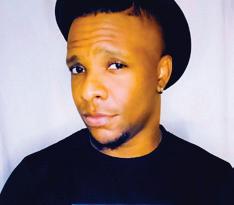
Read full biographies for the 2022–2023
Grant Wood Fellows on our website.

Join us for a conversation between the Smithsonian American Art Museum’s head curator, Randall Griffey, and University of Iowa Stanley Museum of Art director, Lauren Lessing, as they discuss Alice Neel’s 1967 painting The Black Boys, on loan to the Stanley from the Tia Collection in Santa Fe, New Mexico. Griffey, who co-curated the blockbuster exhibition Alice Neel: People Come First, which opened at the Metropolitan Museum of Art in 2021, will share insights into Neel’s work and career and discuss how this exhibition helped the Met widen and diversify its audience.
Prior to joining the Smithsonian in July 2022, Griffey served for nine years as curator of modern and contemporary art for the Metropolitan Museum of Art. In addition to Alice Neel: People Come First, Griffey also recently curated Reckoning with Modernism, part of the expansive sesquicentennial exhibition Making The Met, 1870–2020 (2020). He organized, in close collaboration with the Cree artist Kent Monkman, the groundbreaking Great Hall Commission mistikôsiwak (Wooden Boat People) (2019–2021), a monumental diptych addressing the history and issues of the colonization of North America that became part of the Met’s permanent collection. His efforts at the Met substantially increased the representation of women and artists of color in the collection through major reinstallations and reinterpretations of permanent collection galleries.
Previously, Griffey was a curator of American art at the Nelson-Atkins Museum of Art in Kansas City, Missouri (1999–2008), and curator at the Mead Art Museum at Amherst College (2008–2011), where he also served as head of curatorial affairs in 2012. He completed the Center for Curatorial Leadership program in 2016. He has spoken publicly on a wide range of topics and has written extensively for scholarly and museum publications. Currently, Griffey is a member of the advisory council of the Renee & Chaim Gross Foundation.

Nina Roth-Wells holds a BA in French and art history from Bowdoin College in Brunswick, Maine, and an MA in art conservation, specializing in painted surfaces, from Queen’s University in Kingston, Ontario. For over 20 years Roth-Wells has been a conservator in private practice in the state of Maine. She conserves paintings for both museum clients and private collectors. In addition to her conservation work, Roth-Wells is passionate about conservation education. She teaches professional development workshops to her conservation colleagues and an undergraduate introduction to art conservation course. In this talk, Roth-Wells will discuss how art conservation is a natural bridge between the arts and sciences and how concepts from art conservation can be used in an academic setting to forge interdisciplinary connections in innovative ways.

2 P.M., FEBRUARY 19
2 P.M., APRIL 16
2 P.M., MAY 21
Robert Caputo, an Iowa City–based painter and sculptor, will help you draw inspiration from the museum’s collection then put pencil to paper. Each session will focus on a different artwork. The sessions will begin with an introduction to and discussion of the selected object. Participants will be encouraged to pursue their own visions and to take inspiration from the piece.
Each drawing salon is limited to 15 participants. Visit stanleymuseum.uiowa.edu and reserve your spot today!

This spring, the Stanley Reads book group features What Napoleon Could Not Do, the debut novel of DK (Derek) Nnuro, the museum’s curator of special projects. The club will meet in the galleries three times over the spring semester to discuss the novel and discover how objects in the Homecoming exhibition connect with themes in the book. Nnuro will also be on hand to answer questions about the novel and engage participants in craft discussions. We encourage budding writers—especially writers of fiction—to join us. Everyone is welcome.
What Napoleon Could Not Do is a gripping novel in which America is seen through the eyes and ambitions of three characters with ties to Africa.
Stanley Reads Book Club is presented in partnership with Prairie Lights, where What Napoleon Could Not Do will be available beginning on February 7, 2023. On Wednesday, February 8, Prairie Lights will host Nnuro for a reading followed by a conversation with acclaimed poet and educator Tameka Cage Conley about the book and its themes.
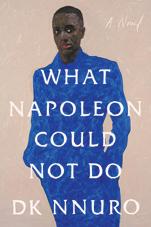
Iowa City is a good two hundred miles from Barrington, the Illinois suburb where Allie Tokarski spent her childhood. She had applied to the University of Iowa impulsively, following the lead of older friends. “After visiting Iowa for the first time, I fell in love,” she recalls—with the campus, the surrounding town, and the dynamic arts scene. Though she can certainly turn a poetic phrase—“I think there’s something about the briskness of fall that awakens my creative energy,” she muses in an email—Tokarski prefers the sculptor’s chisel to the writer’s pen, progressing from AP Drawing and Painting in high school to an art minor in her first months of college. Yet she didn’t consider art practical enough for a major, much less a career path, until she discovered the position of gallery host at the University of Iowa Stanley Museum of Art, then known as the University of Iowa Museum of Art.
Tokarski had just finished her first semester of college and was looking for a work-study job. Then based in the Iowa Memorial Union, the museum’s provisional quarters intrigued her when she initially visited for a class. “The space was not overwhelmingly large, quiet, or reverent,” she remembers. Instead, it seemed intimate and accessible. She also noticed it employed students: “That experience, I think, was the first stroke of luck.”
Tokarski worked for the museum almost every subsequent semester of her undergraduate years, finding supportive colleagues and mentors and ample inspiration for her own practice. Ultimately, she graduated with a BFA in painting, a BA in art history, and the sense that she “didn’t need to prop up or justify studying the arts with another degree that I wasn’t fully passionate about.”
As a gallery host and a curatorial intern, Tokarski learned by example to use art as a teaching tool, watching professors guide their classes through the museum. Those lessons shaped how she approaches her own work at the Stanley, where she’s now assistant curator of student engagement. For the past year, she has led the Stanley Campus Council, overseeing its members and helping them plan events during the spring and fall semesters for an audience of their peers. Most recently, the council partnered with UI MFA candidate Lilah Ward Shepherd, who led a sashiko stitching and mending workshop. It also ran a canned-food and hygieneproduct drive with the UI Food Pantry—providing free necessities for students, faculty, and staff— and explored themes of sustainability, community, and identity in the Stanley’s Visual Classroom by exhibiting textile and garment art from the museum collection. Apart from drafting promotions, crafting posts for the council’s Instagram, liaising with different departments, and creating project budgets, Tokarski is spearheading development of a student docent program and a museum-based student-led creative workshop series.
Despite her many individual endeavors on behalf of the university, she always turns the spotlight back onto its community. She admires the brightness and enthusiasm of the students on the council and entrusts them with responsibilities according to their passions and skills. Her supervisors’ trust in her—along with an open mind and a healthy dose of luck—has allowed Tokarski to blaze a new trail in her position, which is unique

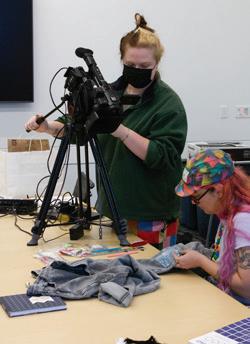
CONTINUES FROM PAGE 29
in the museum’s history. She relishes the fact that “there’s no real cut-and-dried path for my job.” In other words, she can build new programs in the direction of her interests.
Tokarski’s pursuits outside the workplace are as creative as those within. Not only does she experiment with gouache, paper pulp, and drywall mud, but she can also cook and bake everything from caramel pear pie to boeuf bourguignon and has turned her home into a hundred-plant greenhouse. It’s easy to imagine her cats enjoying such a cozy landscape: she and her partner have four, two of whom—Jackson and Morris—are named after abstract painters.
For someone whose professional life revolves around bringing art to a wider audience, she’s surprisingly discreet about her own practice. “I’ve come to appreciate holding my cards a little closer to my chest,” Tokarski explains. “In school I was always rushing to share (on Instagram or in class) what I was working on with other people. But now I’m more content to keep things to myself because, at this point, they’re more for me than anything else.”
Though inspired by the visitors, fellow artists, and the vast collection surrounding her at the Stanley, she values a balance between personal and public—one that ensures her hours in the studio are just as thoughtful and meaningful as her time in the museum.
Longtime University of Iowa supporter Donald W. Heineking (58BSC) has made a gift to the University of Iowa Stanley Museum of Art to ensure that students and visitors can enjoy remarkable exhibitions and programs far into the future. Heineking, former president of Security State Bank in Hubbard, Iowa, established the Donald W. Heineking Fund for Exhibitions and Programs with a gift of $100,000 in 2022. The new endowed fund reflects Heineking’s passion for the arts and commitment to student success at Iowa. He shared, “The arts are an important part of the University of Iowa community, and the new museum will offer generations of students the opportunity to incorporate art and culture into their campus experience.”
In addition to his support for the Stanley, Heineking has previously endowed eight Iowa scholarships and a program fund at Hancher Auditorium. The Stanley Director Lauren Lessing remarked on how Heineking exemplified the way Iowa alums will ensure the legacy of the arts at Iowa: “It’s because of Hawkeyes like Don that the Stanley is able to fulfill our educational mission and leverage our extraordinary collection to enrich the student experience at the University of Iowa. Gifts like his ensure that we can continue to be a great university for the arts.”
Joyce Summerwill is helping current and future generations of art lovers make the most of their experiences at the University of Iowa Stanley Museum of Art. The longtime Stanley supporter, who also is an advisory board member and docent emerita, recently established the Joyce P. Summerwill Art Fund to invest in new acquisitions, collection management and care, programming, and exhibitions. Through her visionary planned gift—and her generous annual donations—Joyce has created an enduring legacy of art support at Iowa.
I hope you will consider following in Joyce’s footsteps. Many Stanley contributors who are 70 1/2 or older give back to us through minimum distributions from their individual retirement accounts (IRAs)—and also by listing the museum as the ultimate beneficiary of their IRAs. If you’re interested in learning more about how you can establish a new fund— named in honor of you or someone you love—to support the Stanley, please reach out to me. I also can help you donate to an existing endowed fund such as the Stanley Sustaining Fund, which provides unrestricted museum support.
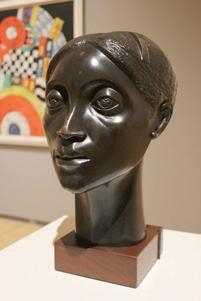
This spring, we will join with the University of Iowa Center for Advancement in hosting a luncheon for generous friends who have included the Stanley in their estate plans. If you qualify—or would like to qualify—to attend this special event, please contact me, at susan.horan@ foriowa.org or 319-467-3407, by Wednesday, March 15, 2023.
Your charitable support will ensure that visitors can continue to enjoy the Stanley Museum of Art far into the future. Thank you for your partnership!
Susan Horan Director of DevelopmentEmail: susan.horan@foriowa.org Phone: 319-467-3407

160 W. BURLINGTON STREET
IOWA CITY, IA 52242
319-335-1727
stanleymuseum.uiowa.edu
